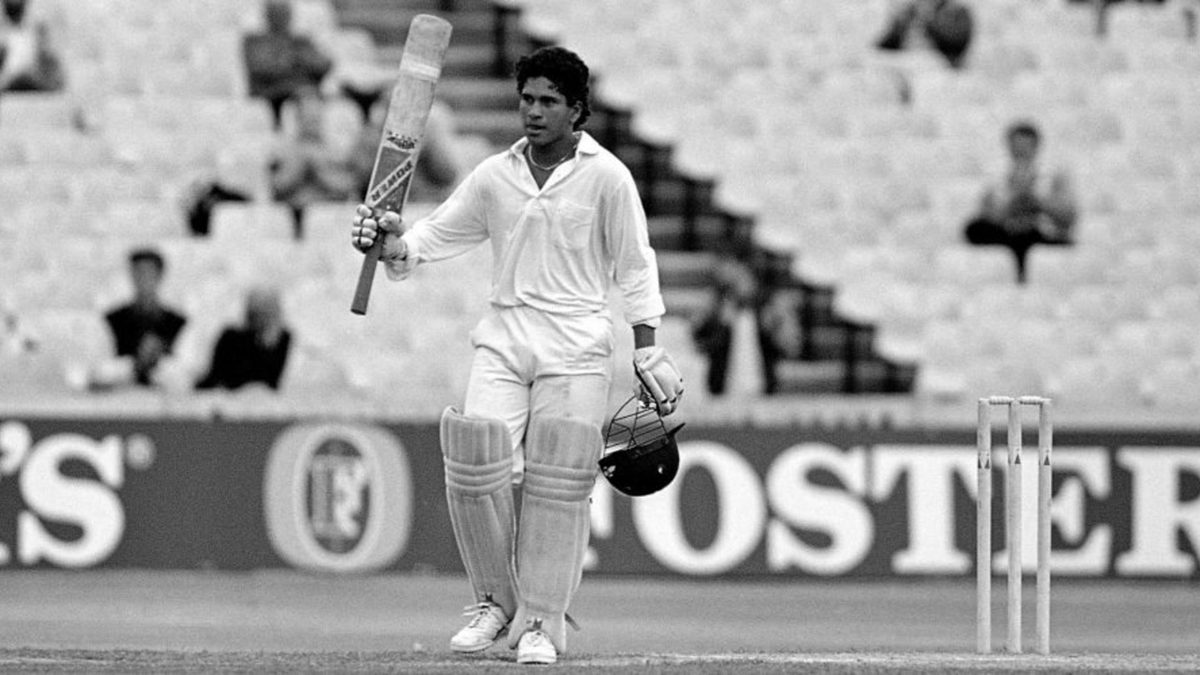
Michael Brown was a ten-year-old when he watched Sachin Tendulkar, at 17, make his first Test hundred. He’s been entranced ever since.
Published in 2008
Published in 2008
1990 and I was sat in front of our family’s wooden encased TV listening to Jack Bannister describing the brilliance of a small 17-year-old Indian batsman in scoring his first Test match hundred against England at Old Trafford. He was only seven years older than me – surely he can’t be playing Test cricket and making batting look so easy? I quickly marked him down as somebody whose career I would follow. He had such crease-presence and played the ball so late and seemed to possess a sixth sense which only some have. His trademark back foot square drive was already in evidence and he hit the shot with minimal effort but exquisite timing. All of this was against no sluggish an English attack consisting of Devon Malcolm, Angus Fraser and Chris Lewis but Tendulkar did not flinch. His maturity was astounding.
Tendulkar’s technique, compactness and range of shots suggested, even at this early age, that he was the complete player. Bowl straight and he whipped you through square leg with ease, yet his front foot pull shot was incredibly brutal. Drop slightly short outside off stump and he punches through the offside. He never looks as though he is trying to hit the ball too hard yet he can be one of the most destructive batsmen in world cricket. Did I like watching him bat because I wanted to copy him? No. I only wished I could copy him. He simply batted in a way that showed that batting could be such a simple skill, yet a skill which could be so aesthetic to the eye. The world saw its first glimpse of Tendulkar at the tender age of 16 and from that day in 1990 I was hooked.
His performance in the 2003 World Cup showed Tendulkar at his peak in one-day cricket and made me feel as though there was a definite place for technically correct batsmen to flourish in one-day cricket (even those with considerably less flair than Tendulkar) following the trials and tribulations of pinch-hitters. He smashed Shoaib Akhtar but was equally skillful and brutal against the spinners with a glittering array of sweeps often followed by twinkly-toed dances down the pitch to hit straight down the ground. Why make batting so complicated, as there is a tendency to do in the current game, when it could be done so effectively and dismissively with simple orthodoxy?
You have to watch India in India to truly to appreciate the pressure that Sachin Tendulkar is under every time he bats. Outside grounds, people wait until he goes in before paying to enter. They seem to want a wicket to fall even though it is their own side that will suffer. This is cricket as Sachin has known it since the age of 16. He grew up under incredible weight of expectation and never buckled once – not under poor umpiring decisions or anything else. Even my county captain Shane Warne picked Tendulkar as his number one cricketer. “I found him slightly tougher mentally,” he argues. “Here is an example of what I mean: in Australia in 2003/04 he was worried about getting out cover driving so he decided to cut out the shot. I saw the wagon wheel for his next innings: he scored 241 without a single cover drive… I have seen him run down the pitch and hit Glenn McGrath over the top for six, and I have seen him hit me for six against the spin going around the wicket… He is quiet and humble. A great player and a great man.” A glowing recommendation indeed, and one that encapsulates Tendulkar as a cricketer, role model and man.
#OnThisDay in 1989, a 16-year-old made his India debut in the Karachi Test against Pakistan.
Since then, there has been:
🔸34,357 international runs
🔸100 international centuries
🔸Billions of happy fansLegend. pic.twitter.com/iR16I7uQFL
— Wisden India (@WisdenIndia) November 15, 2020
At home in Mumbai, Tendulkar’s fan following is so great that he is unable to lead a normal life. Ian Chappell has said that he would be unable to cope with the lifestyle Tendulkar was forced to lead, having to “wear a wig and go out and watch a movie only at night”. Tendulkar has admitted that he sometimes goes for quiet drives in the streets of Mumbai late at night where he would be able to enjoy some peace and silence.
In the current environment, where there are criticisms of sportsmen for their level of histrionics, desire for celebrity and lack of substance, Tendulkar not only performs but does so in a way befitting a truly great sportsman. He recognises his place in the game yet never takes it for granted and always seems to demonstrate a degree of grounding and humbleness that all cricketers should aspire to follow. His God-like status in India only adds to the pressure of being Sachin Tendulkar, but he has taken this in his stride and continues to add to his tally of centuries.
From 1990, I became one of those many people who has to sit down and watch Sachin Tendulkar bat whenever the opportunity arises. A legend in all senses of the word, and my cricketing icon.








